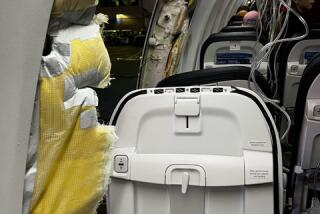747 Lands Safely After Losing Pressure : Aviation: Pan Am Flight 120 makes an emergency return to LAX. None of the 133 passengers and crew aboard were injured.
- Share via
A London-bound Pan American World Airways jumbo jet sustained a sudden loss of cabin pressurization over the Western desert Friday, forcing the pilot to put the airliner into a steep dive and make an emergency return to Los Angeles International Airport, where it landed safely.
No injuries were reported among the 133 passengers and crew.
Pan Am officials released few details of the incident Friday but said the cause of the decompression was not immediately determined.
However, passengers’ reports of a “cold wind” inside the cabin led to speculation of structural failure--like a collapsed door seal or a popped window--somewhere in the fuselage of the Boeing 747. Structural failures have caused rapid decompression in Boeing 747s before, sometimes with tragic results.
Bryon Miglucci, 42, of Fullerton, a passenger aboard Pan Am Flight 120, said the jetliner, which took off shortly after noon, was heading east--presumably at the announced cruising altitude of about 37,000 feet, probably over New Mexico or Colorado--”when there was a bang in the back of the plane. . . .
“The oxygen masks all dropped, and nobody had to tell us what to do,” Miglucci said at the airport afterward. “We all put them on.”
“We were very scared,” said Jane Hinckley, a New Zealander headed for Europe. “We went down so fast that we were pressed back flat against our seats. We could hear the wind rushing and it suddenly got freezing cold.”
The pilot, following emergency procedures recommended by Pan Am and most other airlines in the event of sudden decompression, immediately dove to an altitude at which both passengers and crew could breathe comfortably without oxygen masks or pressurization. Pan Am declined to identify members of the flight crew.
“The scariest thing was that . . . we were dropping for three or four minutes and they never told us that we were going to level off,” said Hal Haemel, a member of the U.S. international sailing team, who was on his way to competition in the Soviet Union.
The passengers said the jetliner finally leveled off at about 10,000 feet and turned west for the return flight to Los Angeles, dumping fuel along the way to lighten the load for a safer landing.
At that point, the pilot advised them that the plane had decompressed and he was returning to Los Angeles.
“I fly a lot, and I noticed that we took an unusual route on the way back, sticking close to all the airports along the way--airstrips in the desert, military bases, fields like Ontario (International Airport), and keeping really low,” Miglucci said. “When we got back to Los Angeles, we landed without incident.”
The airline and the FAA began an investigation immediately. Passengers were offered resumption of the flight on another plane late Friday night, and several said in interviews that they would be on it.
Last February, failure of a cargo door caused explosive decompression aboard a United Airlines Boeing 747 near Hawaii, tearing a hole in the side of the fuselage through which nine people were hurled to their deaths. The crippled plane managed to limp back to Honolulu for a safe landing.
In 1985, failure of the aft pressure bulkhead on a Japanese Airlines Boeing 747 caused sudden decompression that crippled the plane’s controls. The plane slammed into a mountain northwest of Tokyo, killing 520 in the worst single-airplane disaster in aviation history.
The rushing wind and the dropping temperature aboard Flight 120 are strong indications of some sort of structural failure, according to a veteran commercial airline pilot and safety expert who spoke on condition that his name not be disclosed. He said the plane’s pressurization turbines have check values that prevent rapid loss of pressure if the turbines fail.
“It could be a window that popped,” the expert said. “It could be a cargo door seal. That’s what it sounds like to me. But it could have been a lot of different things.”
The expert said the fact that none of the passengers reported fogging in the cabin indicates the decompression was not instantaneous. That, in turn, indicates that whatever aperture was created to permit the decompression was relatively small. Visitors observing one side of the plane from a nearby passenger terminal at LAX said there were no obvious signs of damage on the outside of the fuselage.
In the case of last February’s incident off Hawaii, by contrast, passengers reported fogging after an entire cargo door and a large chunk of the fuselage tore away from the side of the aircraft.
Times staff writers Clay Evans and Marc Lacey contributed to this report.
More to Read
Sign up for Essential California
The most important California stories and recommendations in your inbox every morning.
You may occasionally receive promotional content from the Los Angeles Times.










